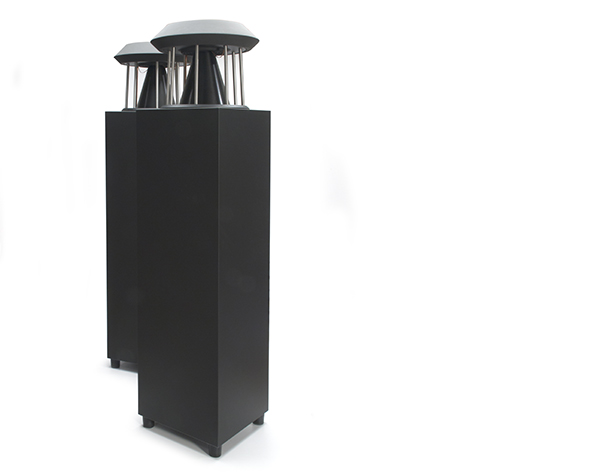Further listening with the Unlimiteds

The entire line of German Physiks speakers, due to their omnidirectional nature, are incredibly easy to place, not requiring a tuned room to give their best performance.
This was readily apparent from the minute we unboxed them, making for the shortest set up we’ve ever encountered. The major upside here is that the Unlimiteds will sound just as good, if not better than what you’ll hear at your dealer.
After a few months of enjoying the Unlimiteds, we took them on a quick, local road trip to confirm this theory, sharing them with a few staff members and a couple of traditionally difficult rooms, as well as a wide range of amplification. As hinted at in the first segment of this review, the Unlimiteds really only require about 25-40 watts to get busy, thanks to a very gentle, unobtrusive crossover network that separates the down-firing woofer and their DDD omnidirectional driver, that covers the frequencies from 200Hz[RK1] on up.
First stop: My living room
You might laugh, knowing that the publisher of TONEAudio probably has one of the worlds most dreadful sounding living rooms on Earth. However, this room’s[RK2] wooden plank floors, large glass coffee table and highly reflective surfaces provides a great torture test, because most speakers usually require a lot of fiddling to even achieve passable sound quality.
This was the first big revelation with the Unlimiteds, and the reflective nature of this 11 x 17 foot room actually played to the strength of the speakers. As I mentioned earlier in the review, the key to setting up the Unlimiteds (and I suspect all GP speakers) is to optimize for smooth, solid bass response. Once accomplished, the rest falls into place nicely. Powered by a Simaudio MOON 700i integrated (150 wpc) and matching CD player, the Unlimiteds create a gigantic soundfield in what is normally a troublesome room. Gato Barbieri’s soundtrack from The Last Tango In Paris has his signature horn floating effortlessly, sounding larger than life, the speakers virtually invisible in the room.
Next stop: Anechoic chamber
Well, not really, but one of my neighbors has a particularly dead room, full of rough hewn siding and an angled wood ceiling (much like staff member Jerold O’Brien) that sucks the life out of most of the speakers we’ve tried there. Because of its absorptive nature, this room presents an equal challenge to my living room that is wildly reflective.
Should you possess a room like this, I suggest placing the Unlimiteds a bit closer together than normal, we achieved a coherent balance with the speakers about 6 feet apart rather than the normal 8-12 foot spread used everywhere else. Due to the room absorbing the reflections that provide much of the spatial information, I also suggest listening in closer than you might in a normal to reflective room.
While the presentation sounded a bit small at the normal ten foot couch to speaker distance, pulling it in to 7 feet from the speakers brought the life and imaging performance back to life, providing an almost nearfield setup. After hearing the Jung Trio’s recent disc of piano and violin, my neighbor also remarked that this was the most lifelike he’d heard acoustic instruments in his troubled space.
The last ingredient for a more benign environment is amplifier power. Where the Unlimiteds could rock the house with 35 wpc in a highly reflective space, it took a couple hundred watts per channel to light them up in this sonically dense environment. My neighbor had this well in hand with a pair of Parasound JC1 monoblocks at the ready. Before long, we were playing Edgar Winter’s “Frankenstein” and clinking beer bottles in triumph[RK3] .
Final stop: House party
A short road trip to a somewhat large room of 20 x 30 feet (with average acoustic properties) quenched my fears that these speakers could not play to a larger room. Again, a little more power helps, but not as necessary as in the dead room. The new Rogers EHF-200 that we have in for review (with 110 watts of KT120 power per channel) proves an exquisite match here, giving the Unlimiteds enough weight and control to really rock some house music.
Thunderball’s “To Sir With Dub” fills the room with solid beats, and after a little bit of experimentation, 11 feet apart is the magic spot for the speakers. Placing the Unlimiteds in a large room provides an excellent listening position everywhere. The image shifts slightly, but nowhere near what it would if you were listening to box speakers. Whether sitting on the couch, standing off to the side or even sitting on the floor, well off axis, a great stereo perspective is achieved. On many levels, these could be the ultimate speakers for your next party, because everyone can enjoy the music. The Unlimiteds wide dispersion and smooth response also allows enjoyment of the music at a lower level than you would need from a pair of box speakers.
Mid way through the party, when someone got carried away with the volume control, reminiscing college days (and for me, that’s the late 70s) and cranking up Styx’ The Grand Illusion, we all got a chance to see that these speakers could deliver high sound pressure levels without fatigue and not lose their composure.
At the evening’s close, many of my host’s friends asked about the speakers, which were surprising, as there was, not an audiophile in the crowd. Proof positive that you don’t have to be an audiophile to appreciate great sound.
Wrapping up
Living with the German Physiks Unlimited II loudspeakers has proved illuminating in many ways. This is a pair of speakers that can be used in virtually any environment with a wide range of amplification, and requires minimal set up fuss. Their tiny footprint and contemporary shape should also help them to blend into any décor situation as well.
Highly recommended.
And, after speaking with Robert Kelly, GP’s director of sales, they will be showing these speakers at the Rocky Mountain Audio Fest again this year, with a show special price, for those interested. Tell them we sent you!



